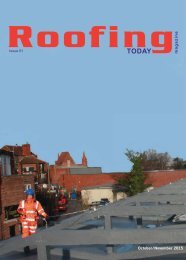Roofing
Roofing%20Today%20Issue%2065%20July%202016
Roofing%20Today%20Issue%2065%20July%202016
You also want an ePaper? Increase the reach of your titles
YUMPU automatically turns print PDFs into web optimized ePapers that Google loves.
Heritage <strong>Roofing</strong><br />
Are You Feeling the Summer Love?<br />
Dr Chiara Ceci, The Royal Society for the Protection of Birds (RSPB)<br />
Image: Alan Georgy<br />
Can UK roofing and swifts be the best of friends or are<br />
these archetypal summer birds a costly nuisance to<br />
roofers and their clients? One of the main concerns,<br />
when it comes to birds nesting in or around roofs, is that<br />
people worry about the mess they might make, but with<br />
swifts there are no such problems; they are probably the<br />
cleanest of birds, stay only 12 weeks each year and are<br />
very helpful in getting rid of mosquitoes and other flying<br />
insects.<br />
“Swifts are the best tenants you could hope for and if you<br />
are lucky enough to have them nesting near you, under a<br />
loose roof tile or under the roof’s eaves, you should feel<br />
privileged to share your building with these amazing<br />
birds,” says Rebecca Pitman, RSPB Swift Cities Project<br />
Officer.<br />
“Swifts are the quintessential sign of summer. There’s<br />
nothing like seeing and hearing them rocket over rooftops<br />
on a summer’s evening. They are charismatic, enigmatic<br />
and one of the fastest flying birds in the world.<br />
“Swifts are only in the UK for three months of the year,<br />
from April to August, and make practically no mess<br />
where they nest, so they are the ideal tenants to have<br />
nesting in your roof. In fact, most people don’t even<br />
realise the swifts are there – the perfect houseguest!”<br />
Rebecca adds.<br />
Despite being low maintenance, swifts are facing an accommodation crisis, and<br />
the RSPB is appealing for help from roofers for these intriguing birds over the<br />
summer. When they arrive back in the UK they return to the exact same location<br />
year after year. Swifts like to nest in the roofs of old buildings, but renovation,<br />
insulation and development often destroy suitable sites. Rebecca explains:<br />
“Swifts have declined by an alarming 38% since 1995 and are now an amberlisted<br />
species on the list of Birds of Conservation Concern.<br />
“We don’t know the exact causes of their decline - it could be a variety of issues<br />
along their migration routes, including loss of insect food availability or climate<br />
change - but the RSPB believes loss of nest sites in the UK is at least partly<br />
responsible.”<br />
Swifts could become extinct as a breeding species in the UK if we don’t all do<br />
something about their plight.<br />
Because the decline of swifts is caused by the disappearance of nesting sites,<br />
roofers and builders could be the best friends of these beautiful and precious<br />
birds.<br />
Edward Mayer, a swift and building expert, founded Swift Conservation and<br />
provides training and advice on the conservation of swifts and the enhancement<br />
and support of urban biodiversity. “If well-built and installed, the boxes need no<br />
maintenance, nor do they ever need to be cleaned out, as swifts are probably the<br />
cleanest of birds, making minimal nests that mostly degrade and disappear over<br />
winter.”<br />
It is easy to help swifts without causing any adverse effects and without<br />
compromising the building. All that is needed is a box or a hole, with suitably<br />
t<br />
Page 24 <strong>Roofing</strong> Today<br />
Enquiry 42




